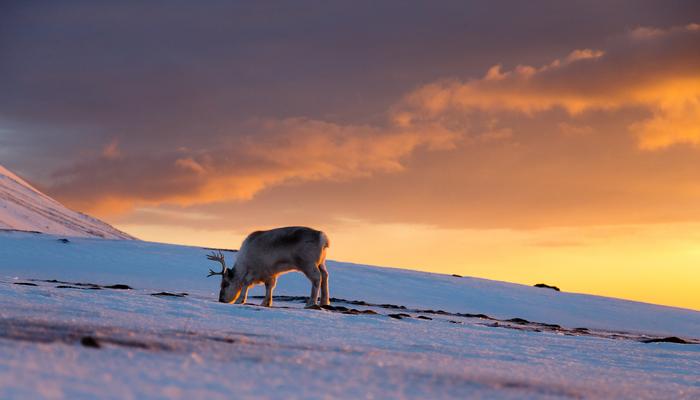When Santa’s exhausted reindeer finally set down their sleigh in the deep snow of the North Pole early Christmas morning, it’s not Rudolph’s radiant red nose that will help them find sustenance in the barren landscape.

Credit: Photo by Espen Bergersen
When Santa’s exhausted reindeer finally set down their sleigh in the deep snow of the North Pole early Christmas morning, it’s not Rudolph’s radiant red nose that will help them find sustenance in the barren landscape.
Instead, researchers from Dartmouth and the University of St. Andrews in Scotland report that the eyes of Rudolph and his reindeer brethren may have evolved so that they can spot their favorite food during dark and snowy Arctic winters, according to a new study in the journal i-Perception.
The findings help explain the long-standing scientific mystery as to why reindeer can see light in the ultraviolet (UV) spectrum—and add intrigue to the smiling airborne ungulates popularized in the classic story by 1926 Dartmouth graduate Robert L. May.
“Reindeer are so cool, but many people think about them only at Christmas,” Nathaniel Dominy, first author of the study and the Charles Hansen Professor of Anthropology at Dartmouth says. “Now is a good time to alert people to their extraordinary visual system.”
Reindeer subsist primarily on reindeer moss, or Cladonia rangiferina, which isn’t a moss but actually a species of algae-fungus fusion known as lichen. C. rangiferina forms thick crunchy carpets across northern latitudes and is so integral to the survival of reindeer that even its formal name stems from the scientific term for reindeer, Rangifer.
The researchers worked in the Cairngorms mountains in the Scottish Highlands, which host Britain’s only reindeer herd—reintroduced from Scandinavia after being hunted to extinction locally—and more than 1,500 species of lichen. Despite these options, reindeer in the Cairngorms rely on C. rangiferina during the winter.
“A peculiar trait of reindeer is their reliance on this one type of lichen,” Dominy says. “It’s unusual for an any animal to subsist so heavily on lichens, let alone such a large mammal.”
To the human eye, the white lichen is invisible against the snowy backdrop of an Arctic winter.
But Dominy and co-authors Catherine Hobaiter and Julie Harris from St. Andrews discovered that C. rangiferina and a few other lichen species that supplement the reindeer diet absorb UV light. Spectral data from the lichen and light filters calibrated to mimic reindeer vision revealed that these organisms appear to reindeer as dark patches against an otherwise brilliant landscape, making them easier to locate.
“Getting a visual approximation of how reindeer might see the world is something other studies haven’t done before,” says Dominy, who published a paper in 2015 on how Rudolph’s red nose would’ve acted as an effective foglamp in the haze of winter.
“If you can put yourself in their hooves looking at this white landscape, you would want a direct route to your food,” he says. “Reindeer don’t want to waste energy wandering around searching for food in a cold, barren environment. If they can see lichens from a distance, that gives them a big advantage, letting them conserve precious calories at a time when food is scarce.”
Previous research has shown that reindeer eyes change between summer and winter, Dominy says. Their tapetum—the light-enhancing membrane that gives many animals “shiny” eyes—transitions in winter from the golden color most animals have to a vivid blue that is thought to amplify the low light of polar winter.
“If the color of the light in the environment is primarily blue, then it makes sense for the eye to enhance the color blue to make sure a reindeer’s photoreceptors are maximizing those wavelengths,” Dominy says.
But the blue tapetum also lets up to 60% of ultraviolet light pass through to the eye’s color sensors. That means that reindeer see the winter world as a shade of purple, similar to how a person would see a room with a black light—UV-reflecting surfaces such as snow shine brightly while UV-absorbing surfaces are starkly dark.
The researchers recount how scientists have sought to answer why the eyes of an Arctic animal that is active during the day would be receptive to the UV light that would be reflecting off of every snow-covered surface. But their study suggests that the answer is tied to what UV light doesn’t reflect from—C. rangiferina and other bushy lichens.
Given the importance of lichens in the reindeer diet, the researchers report, it is possible that the animal’s eyes are optimized to single out this food staple at the time of year it would be most difficult to find.
So, while the luminescent nose of the most famous reindeer of all “may light the way for Santa to see by,” the researchers write, “it is Rudolph’s blue eyes that allow him to find dinner after a long Christmas season.”
Journal
i-Perception
DOI
10.1177/20416695231218520
Method of Research
Experimental study
Subject of Research
Animals
Article Title
Reindeer and the quest for Scottish enlichenment
Article Publication Date
15-Dec-2023




